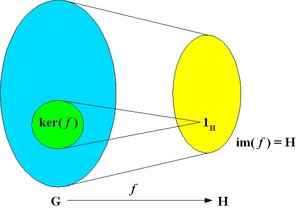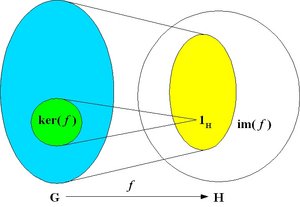Group homomorphism
From Online Dictionary of Crystallography
Revision as of 14:14, 19 March 2009 by MassimoNespolo (talk | contribs) (→Homorphisms between G and H ≠ G)
Homomorphisme de groupes (Fr). Gruppenhomomorphismus (Ge). Homomorfismo de grupos (Sp). Omomorfismo di gruppi (It). 準同形 (Ja).
Contents
[hide]Groups
Let G and H be two non-empty sets with binary operations * (in G) and # (in H). If * and # are associative in G and H respectively and if G and H contain an identity element and the inverse of each element in them, then (G, *) and (H, #) are two groups.
Homomorphism between groups
A group homomorphism from (G, *) to (H, #) is a function f : G → H that preserves the composition law, i.e. such that for all u and v in G:
f(u * v) = f(u) # f(v).
The function f maps the identity element 1G of G to the identity element 1H of H, and it also maps inverses to inverses: f(u-1) = f(u)-1.
Kernel and image
The kernel of the homomorphism is the set of the elements of G that are mapped on the identity of H:
ker( f ) = { u in G : f(u) = 1H }
The image of the homomorphism is the subset of elements of H that are mapped by the homomorphism f:
im( f ) = { f(u) : u in G }.
The kernel is a normal subgroup and the image is a subgroup of H.
Types of homomorphisms
Homomorphisms can be classified according to different criteria, among which the relation between G and H and the nature of the mapping.
Homomorphisms mapping elements of different sets (G ≠ H)

An epimorphism is a surjective homomorphism, that is, a homomorphism which is onto as a function. The image of the homomorphism spans the whole set H: in this case, img( f ) = H
A monomorphism is an injective homomorphism, that is, a homomorphism which is one-to-one as a function. In this case, ker( f ) = {1G }.
If the homomorphism f is a bijection, then its inverse is also a group homomorphism, and f is called an isomorphism; the groups (G,*) and (H,#) are called isomorphic and differ only in the notation of their elements, while they are identical for all practical purposes.
Homomorphisms mapping elements of the same set (G = H)
An endomorphism is a homomorphism of a group onto itself: f: G → G.
A bijective (invertible) endomorphism (which is hence an isomorphism) is called an automorphism. The set of all automorphisms of a group G forms itself a group, the automorphism group of G, Aut(G).
